Q&A with the Author
- What made you decide to write this book?
- What was the hardest part of writing it, and what was the easiest?
- What is one important lesson or message you hope readers take away from the book?
- Are there any other books that greatly influenced your writing process and/or your research?
- What led you to your specific area of study (the subject of your book)?
- Are there any common misconceptions about the topic?
- What advances do you hope we will see in the next 10 years?
- What made you decide to go into the field of mental health?
- When you are not working, what do you do for fun?
- What is your all-time favorite book?
- Is there a project that you are excited to work on next? (A presentation, a workshop, writing another book, etc.)
Tell us more about your latest book!
What made you decide to write this book?
First, let me say that I wrote The Therapeutic Relationship in Cognitive-Behavioral Therapy in close collaboration with two coauthors, Nikolaos Kazantzis and Keith Dobson. They have contributed their thoughts and reflections to this Q&A as well.
All of us are excited to offer this unique and comprehensive work on the therapeutic relationship in CBT. We felt compelled to condense our combined 100 years of clinical and academic experience into a written work that we believe reflects the essentials of developing an effective therapeutic relationship. While many clinicians may believe that the therapeutic relationship is something that they develop early on, it is a process that is much more nebulous and complex.
We decided to write this book because there were very few works on the professional market that pertain to this topic and we believe that we offer some very unique aspects that both students and seasoned clinicians need to know. This book adopts the “first principle” approach used in science. Here, it involves the identification of the foundational elements of the therapeutic relationship. We present frameworks for understanding the smallest elements that form the building blocks of the therapeutic relationship in CBT: collaboration, empiricism, and Socratic dialogue. This is the first book to do so. The knowledge gained is therefore very unique, and both students and seasoned clinicians need to know it.
What was the hardest part of writing it, and what was the easiest?
Clearly, to define, measure, and discuss elements of the therapeutic relationship is not easy. Building on our individual experiences as clinicians, and our independent research programs, this book reflects about 7 years of our collaborative work within the Cognitive Behavior Therapy Research Unit, based at Monash University, to which we all contribute. This book is an important dissemination avenue for our research. Perhaps including our respective bios for the cover flap was the only easy part about writing the book!
What is one important lesson or message you hope readers take away from the book?
Our one main message is that there is a series of related challenges to establish an effective therapeutic connection with clients. This process isn’t something that just happens spontaneously. There is a great deal of work and skill that goes into developing and managing the therapeutic relationship. Knowing the elements and how they can be flexibly adapted for the client in a moment-to-moment case conceptualization provides a clarity and fluidity to human interaction in therapy. It is ironic that understanding the detailed component parts affords a distance, perspective, and ability to be more “present” or “whole” as a human being with the client. We believe this is because of the clarity these ideas provide in the therapist’s mind.
Are there any other books that greatly influenced your writing process and/or your research?
There are many books that have influenced the wisdom that is integrated into this text. However, the one that stands out the most is probably the 1979 Cognitive Therapy of Depression. In our opinion, this is still one of the best written and comprehensive texts on cognitive behavior therapy that exists in the professional literature.
We are interested in learning more about your expertise.
What led you to your specific area of study (the subject of your book)?
Probably the fact that no matter what type of treatment one is conducting and the problems that are encountered in treating a particular individual, the fulcrum of treatment involves the relationship that develops between yourself and the client. This has not been studied very well at all. If we consider the advances that have been made over the past 50 years in psychotherapy process research, we haven’t made all that many gains. We still center on the “alliance”, which is generally operationalized as client-therapist agreement plus the therapeutic bond. Centrally important relational elements to CBT, such as collaboration, empiricism, and Socratic dialogue seem to have been missed.
Are there any common misconceptions about the topic?
There are a number of misconceptions. From a clinical research standpoint, misunderstandings are: (1) that treatment effectiveness is due to “common factors” across therapies, when every clinician knows specific relational elements that have very different mechanisms in different models (i.e., collaboration requires careful tailoring for each client, and has different functions in CBT from interpersonal therapy, for example); and (2) that the concept of the “alliance” captures the whole relationship, when really it is operationalized as overt statement of “agreement” on goals and tasks within the context of a bond. The alliance is important, but to equate it with the relationship would be to oversimplify a very complicated instance of human interaction.
From a clinical practice standpoint, a misconception is that developing a therapeutic relationship is easy and does not require any specific skill or practice. Relatedly, some people think that you either have a positive way of being and ability to develop effective relationships or you don’t. These are probably two of the biggest distortions that exist among therapists and in our opinion are often associated with treatment failure. The other is the concept that resistance on the part of the client is something that is always negative and undesirable. Understanding the essence of resistance is important before one can successfully address it and embrace it (i.e., through repair of ruptures). Hence, resistance is not necessarily a “bad” or “negative” thing, but something that needs to be “worked through” and often becomes “grist for the therapeutic mill.”
What advances do you hope we will see in the next 10 years?
We hope that this work will inspire other research groups to examine domain-specific therapeutic relationship-outcome relations. We also need to better understand the causal determinants of relational elements. Once we have published our empirical studies, we will make our measures (based on the competence frameworks in this book) freely available to the scientific community. However, we would really like this book to inspire fresh research ideas in this area, if possible.
Now a little bit about you…
What made you decide to go into the field of mental health?
The three of us have always been fascinated with human behavior, particularly what makes people think and act the way they do. Also, the notion of reducing human suffering and promoting salubrious mental health was probably one of the biggest draws to the field for the three of us. The fact that we can make a significant difference with someone’s life by virtue of developing the therapeutic relationship and selecting the right techniques and facilitative maneuvers is a very powerful and important plus for us.
A value that we each share is that professional fulfillment comes from “losing oneself in service” and we’ve dedicated our professional lives to helping others grow and to reduce human suffering.
When you are not working, what do you do for fun?
Keeping it light and easy is the key to rejuvenation on our down time. Whether it’s putting in hours at the gym, hiking, playing sports, jogging, kayaking, bike riding, time with the family or grandchildren, or eating too much Greek and Italian food, all of these are big winners for us. In fact, the three of us “hatched” the idea for the book over a Mediterranean dinner in 2010 at the World Congress in Boston. We always make a point of taking the time for the personal relationships the three of us share whenever we’re in the same town as each other.
Perhaps the old adage is true: when you are committed to something that’s important enough, you do it even when the odds are against you. Our research program brings a new perspective and new measures to something familiar. The work is not easy. We wanted to contribute a quantum leap forward in perspective. The simple fact is, we are people first and foremost, clinicians second, and researchers third – we witness the power of a human interaction in therapy, and we felt the current state of psychotherapy research was quite invalidating of its importance. To render the relationship as being simply a proportion of “variance accounted for” pits relationship vs. technique, and misses the point that both are intertwined.
What is your all-time favorite book?
Probably we each have a unique response to this item. For Frank Dattilio it is Brave New World by Aldous Huxley. For Nikolaos Kazantzis it is a close tie between three: Epictetus’ Enchiridion, Nikos Kazantzakis’ Zorba the Greek, and George Orwell’s 1984. Keith Dobson’s choice is Siddhartha by Herman Hesse.
Is there a project that you are excited to work on next? (A presentation, a workshop, writing another book, etc.)
Frank Dattilio: Taking a nap in the middle of the afternoon.
Nikolaos Kazantzis: The next series of studies on CBT process-outcome relations!
Keith Dobson: A large dissemination project in China for cognitive-behavioral therapy in perinatal depression.
See all titles by and read more about Frank M. Dattilio on his author page!













